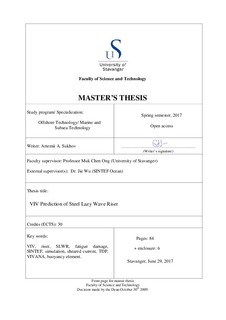| dc.description.abstract | Deepwater oil and gas production is complicated by the structural complexity and uncertainty in prediction of the riser’s behavior. To date, Steel Lazy Wave Riser (SLWR) has been chosen as one of the most attractive riser designs in deeper waters and harsher environments since its buoyancy part absorbs the motions of the platform/vessel decoupling the Touchdown Point (TDP). When subjected to currents, risers may suffer Vortex-Induced Vibrations (VIV). VIV are caused by alternating shedding of vortices from both sides of the structure. If the frequency of vortex shedding is close to the riser’s natural frequency, it may lead to rapid accumulation of bending stresses causing to fatigue damage.
The vortex shedding process for bare and buoyancy part of SLWR is different due to the difference in diameters. Consequently, the VIV responses of the buoyancy section (which consists of the parts of both diameters) will be governed by the interaction of these two processes. The main factors influencing this interaction are the length of buoyancy section, diameter of the buoyancy elements, their arrangement, etc. Thus, there is a strong need to perform VIV analyses for different staggered buoyancy element configurations in terms of the riser fatigue performance.
The riser may oscillate in both Cross-Flow (CF) and In-Line (IL) directions. Most of the riser VIV analyses have been performed in pure CF motions since it was assumed that the IL response’s contribution to fatigue damage is insignificant compared to CF one. However, it has been indicated that the IL fatigue damage becomes significant for long cylindrical structures (Baarholm et al., 2006). Thus, in order to consider the contribution from the IL, CF responses and also from their combinations, the VIV analysis including combined CF and IL motions should be performed.
In this thesis, based on the experimentally obtained hydrodynamic data, three different SLWR configurations have been built and analyzed using the VIV prediction program VIVANA. Since the vortex shedding frequency behavior around the structure is uncertain, there are two options to determine the excitation zones used in this program. Their principles are based on the following assumptions: frequencies act on the structure concurrently (space sharing option) or consequently (time sharing option).
With reference to the above mentioned, the following analyses have been performed in the present work:
• Investigation of sensitivity of different buoyancy element configurations on the CF fatigue damage;
• Investigation of the combined CF and IL prediction for the base case configuration;
• Investigation of the space sharing and time sharing options for all configurations.
As a result, all the analyses have been successfully performed; some key findings are listed below:
• The sensitivity analysis results have shown an insufficient fatigue performance of two SLWR configurations with staggered buoyancy elements due to the high bending stresses in the buoyancy sections;
• In the base case VIV analysis with combined CF and IL motions (using both uniform and sheared current profiles), the fatigue damage calculated at 45, 135 and 180 (IL) degrees to the flow direction was dominating for some of the cases;
• The fatigue damage results obtained using the space sharing option, have been generally bigger compared to the time sharing case.
In the present work, all obtained results have been stated and discussed; recommendations for further work have been also given. | nb_NO |
